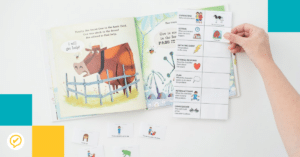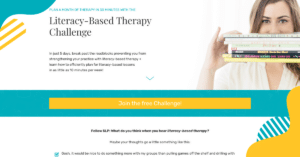Listen on Apple Podcasts Listen on Spotify
We are continuing with our new podcast series, Strategies You Can Use! I’ve been sharing different evidence-based strategies to help target specific skills.
Today I’ll discuss different strategies on how to target narratives! We will focus on 3 evidence-backed strategies on how to target summarizing.
3 Strategies to Target Summarizing
✨Before we dive into the 3 strategies, I wanted to provide some evidence to get you excited about targeting summarizing✨
✓ Teaching students (grades 6-8 with LD) how to summarize and find the main idea is effective in improving understanding of the text (Solis et al., 2011).
Solis, M., Ciullo, S., Vaughn, S., Pyle, N., Hassaram, B., & Leroux, A. (2011). Reading comprehension interventions for middle school students with learning disabilities. Journal of Learning Disabilities, 45, 327–340.
1. What is most important?
“Get the Gist”
✓ A way to scaffold finding the main idea
✓ Who or what is this section about?
✓What is the most important idea about the who/what?
✓Write the gist.
If students struggle…
🍎 remind them to go back to the text.
🍎 remind them to look at the text structure (e.g., “If it’s a problem-solution passage, the main idea will tell the problem and the solution about the who/what.”)
✨ After 25 sessions, students were better at stating main idea and understanding text structures.✨
Stevens, E. A., Vaughn, S. House, L., & Stillman-Spisak, S. (2019). The effects of a paraphrasing and text structure intervention on the main idea generation and reading comprehension of students with reading disabilities in grades 4 and 5. Scientific Studies of Reading.
2. Use self-monitoring tools.
✓ This can improve reading comprehension.
3. Use explicit instruction.
✓ modeling
✓ feedback
✓opportunities for guided and independent practice
✓teach text structure
Scaffold instruction.
✓ Explicitly describe text structures.
✓ Model use of the strategy.
✓ Use graphic organizers.
✓Gradually give students more ownership.
✓ Gradually increase the complexity of the passages.
Focus on 1-2 structures (e.g., compare/contrast, cause-and-effect).
✨ Students with learning disabilities showed the biggest benefits. Younger students (early elementary) showed larger improvement. ✨
Pyle, N., Vasquez, A.C., Lignugaris/Kraft, B., Gillam, S., Reutzel, D.R., Olszewski, A… Pyle, D. (2017). Effects of Expository Text Structure Interventions on Comprehension: A Meta-Analysis. Reading Research Quarterly, 52(4), 469–501.
Need goal ideas for Summarizing?
🎯 Check out SLP Now Goal-bank for some inspiration
Additional Links
Interested in any of the materials mentioned in this podcast? Join our Free 14 day SLP Now Trial Your first 5 downloads are on us!
Summarizing Bundle– Included in the SLP Now Membership
Next Up in this Pod Series
7/5/22 Strategies You Can Use: Following Directions
7/12/22 Strategies You Can Use: Grammar
7/19/22 Strategies You Can Use: Syntax
8/2/22 Strategies You Can Use: Basic Concepts
8/9/22 Strategies You Can Use: Basic Concepts
8/16/22 Strategies You Can Use: Affixes
8/23/22 Strategies You Can Use: Narratives
8/30/22 Strategies You Can Use: Summarizing
Subscribe & Review on iTunes
Are you subscribed to the podcast? If you’re not, subscribe today to get the latest episodes sent directly to you! Click here to make your listening experience auto-magic and as easy as possible.
Bonus points if you leave us a review over on iTunes → Those reviews help other SLPs find the podcast, and I love reading your feedback! Just click here to review, select “Ratings and Reviews,” “Write a Review,” and let me know what your favorite part of the podcast is.
Thanks so much!
Transcript
Marisha: Hello there and welcome to the SLPNow podcast, where we share practical therapy tips and ideas for busy speech language pathologists. Grab your favorite beverage and sit back as we dive into this weeks episode.
Marisha: Hey there, it's Marisha, and welcome to the SLPNow podcast. This summer, we are doing a series called Strategies You Can Use, and we picked different goal areas and we're going to do a blitz of three evidence backed strategies that you can use when targeting those specific skills. So these are mostly strategies that have come from the literature, and we're just pulling out the ones that are most practical that might help you if you're feeling stuck or just wanting to try some new strategies when targeting some of our most common goals. So without further ado, let's dive right in.
Marisha: Today, we are going to talk all about summarizing. And before we dive into the three evidence backed strategies, I just wanted to give a little bit of context and just open up the room for some discussion in terms of why we would even want to target this and why it matters. I really think this is an important discussion to have, especially with our students, but also with ourselves as we're writing these goals and sharing them with the IEP team.
Marisha: So just a little bit of evidence to back up why we might want to do this. So Lisa All, in 2011, did a review of different reading comprehension interventions for middle school students with learning disabilities. And they stated that teaching students how to summarize and find the main idea is effective in improving understanding of a text, which makes sense. It's a good comprehension strategy.
Marisha: So that's the rationale that we might want to use when deciding if this is a good goal area or not and some ways that this can apply. So we summarize any expository text that we might come across to help us kind of comprehend and make sense of it. So this applies in all areas of the curriculum, whether they are reading something in social studies or science or even math. There's a lot of different subject areas where they are presented with expository text. Students are expected to read it and comprehend it and be able to apply it to assignments or when completing tests.
Marisha: And so this is just a really critical skill across all areas of the curriculum. And it's really fun to be able to support it because we get to use all of those relevant texts. This can really have a huge impact for our students in being able to access their curriculum and increasing their independence and ability to learn, like read to learn. And then also, it'll be a huge life skill as they move forward. Whether if they're reading the news and trying to make sense of current events or any other number of expository texts that we might be reading and trying to make sense of.
Marisha: For our practical strategies, the first strategy, this comes from Stevens et al. in 2019, and they share a strategy. They looked at an intervention where they had students paraphrase and provided text structure intervention. And this was with fourth and fifth grade students. And again, if you want to find any of the reference lists or access any of the resources that we discuss during this episode, you can go to slpnow.com/133. So slpnow.com/133. And you can find the show notes with all of the details there.
Marisha: So diving into the actual strategy, one of the strategies that came out of that article was to identify what's most important in the section of text that we're working on. So we can kind of get the gist, express what's most important, in a shortened form. And get the gist is a way to scaffold students in finding the main idea. I don't know about you guys, but at least in the past, when I asked my students what the main idea was, they would just read the first sentence and cross their fingers and toes and hope that's what I meant. They were learned just to look at the first sentence to determine the main idea. And as we all know, there's a lot more to the main idea than just identifying the first sentence, but it's a little bit hard to explain and break that down.
Marisha: So I really like this, how they approach scaffolding students and finding the main idea. So there's two questions. Who or what is this section about? So who or what are they talking about? And then what is the most important idea about that who or what? So what an amazing way to break that down. And instead of just asking, "What's the main idea?" If the students say, "I don't know," or they go for the first sentence, we can break it down a little more and ask who or what is this section or this paragraph or this page, who or what is it about, and what's most important about this who or what? And then they can just have the who or the what and the most important thing about it. And that's the gist, and they get to write that down.
Marisha: So that's one really great strategy is scaffolding it, asking those two questions. And if students struggle with that, there's a couple things that we can do. So we can remind them to go back to the text and kind of look for the who or what, and the most important idea about it. We can also remind them to look at the text structure. So for example, if it's a problem solution passage, the main idea will tell the problem and the solution about the who or what. And so we can teach them to identify those structures and then use that to help them decide what they need to pull to identify the main idea.
Marisha: Using this intervention approach, after about 25 sessions, students were better at stating the main idea and understanding text structures. So I definitely would recommend checking out this article if you want more details on this approach. But I think for me a huge takeaway was having those two questions in my back pocket so that if students give me a blank stare when I ask for the main idea, I have a really nice way to scaffold them in finding that. And then also just remembering that we can remind them to go back to the text. We can remind them to look at the text structure and do some teaching on the text structure to support that skill.
Marisha: Then the second strategy is to use self-monitoring tools. So having the students check in with themselves and see if they can identify the main idea, or check in with themselves, like did I understand what was said in this paragraph or on this page? And just having those strategies to check in with themselves, make sure they're comprehending. And if they're not, using some strategies, additional strategies, like the ones we just talked about, to help themselves break down that text.
Marisha: Then the third strategy is to use explicit instruction in this process. So in identifying the main idea and key details, we can start off by modeling that process. So instead of just like giving the student a text and like, "Okay, what's the main idea?" And if they struggle, just going into scaffolding, we can start off by reading the passage and modeling what that looks like and giving them a couple examples of what it looks like to use those strategies and using that meta talk of like, okay, we just read this. Now I'm going to ask myself who or what is the section about? And what's most important about the who or what? Model identifying that text structure and looking back at the text to answer those questions.
Marisha: And then also, once they've gotten some exposure to that, we can transition the workload to them where we're having them answer more of those questions. We'll strategically decrease that support. Maybe first we have a visual and we're modeling that whole process. And then we have the visual and we just have some prompts or cues and ask some of those questions, but put more ownership on the students to complete the task. And then just gradually decreasing that support to the point where they're doing that independently. By doing that, we're giving them lots of models, lots of feedback, lots of opportunities for that guided and independent practice.
Marisha: And we alluded to this in the first strategy, but another component of explicit instruction can include teaching text structure. So we might start off by explicitly describing some text structures. Maybe we just teach a handful. We then describe the text structures, give them some examples, then model using that strategy, once we've gotten the text structures. And then we can use graphic organizers and just gradually give students more ownership as we go through more examples and as they become more familiar, as they have more exposure to that meta talk and just familiarity with that "procedure."
Marisha: Some other things to consider is just gradually increasing the complexity of the passages. So we might start with really simple passages or maybe a short paragraph within a larger article. And then we can gradually increase to work on different structures.
Marisha: And then when we're teaching the text structure, so this comes from Pile et al. in 2017. They did a really nice meta-analysis of expository text structure intervention. So that would be another great article to dive into if you're wanting to explore this. And it's not just for secondary students. They actually use this with early elementary students as well and it showed significant improvements.
Marisha: They also recommend just focusing on one or two structures at a time. So maybe we start off with compare and contrast and cause and effect, and then go through several examples of that. And once we start to get mastery, we might add in another type of structure, like a problem solution passage, for example.
Marisha: So that is a wrap on the strategies for summarizing. And this also wraps up our series on Strategies You Can Use. I hope this was a helpful series. And again, check out the show notes, if you want to access any of the resources or the reference list. And you can find that at slpnow.com/133. And I can't wait to see you next week, where we dive into all things assessment. Have a good one.
Marisha: Thanks for listening to the SLPNow podcast. If you enjoyed this episode, please share with your SLP friends and don't forget to subscribe to the podcast to get the latest episode sent directly to you. See you next time.
Sign up to receive email updates
Enter your name and email address below and I'll send you periodic updates about the podcast.




You are amazing! Thank you!